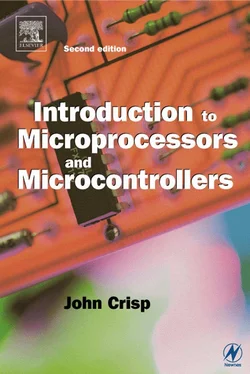John Crisp - Introduction to Microprocessors and Microcontrollers
Здесь есть возможность читать онлайн «John Crisp - Introduction to Microprocessors and Microcontrollers» весь текст электронной книги совершенно бесплатно (целиком полную версию без сокращений). В некоторых случаях можно слушать аудио, скачать через торрент в формате fb2 и присутствует краткое содержание. Год выпуска: 2004, ISBN: 2004, Издательство: Elsevier, Жанр: Компьютерное железо, на английском языке. Описание произведения, (предисловие) а так же отзывы посетителей доступны на портале библиотеки ЛибКат.
- Название:Introduction to Microprocessors and Microcontrollers
- Автор:
- Издательство:Elsevier
- Жанр:
- Год:2004
- ISBN:0-7506-5989-0
- Рейтинг книги:3 / 5. Голосов: 1
-
Избранное:Добавить в избранное
- Отзывы:
-
Ваша оценка:
- 60
- 1
- 2
- 3
- 4
- 5
Introduction to Microprocessors and Microcontrollers: краткое содержание, описание и аннотация
Предлагаем к чтению аннотацию, описание, краткое содержание или предисловие (зависит от того, что написал сам автор книги «Introduction to Microprocessors and Microcontrollers»). Если вы не нашли необходимую информацию о книге — напишите в комментариях, мы постараемся отыскать её.
Introduction to Microprocessors and Microcontrollers — читать онлайн бесплатно полную книгу (весь текст) целиком
Ниже представлен текст книги, разбитый по страницам. Система сохранения места последней прочитанной страницы, позволяет с удобством читать онлайн бесплатно книгу «Introduction to Microprocessors and Microcontrollers», без необходимости каждый раз заново искать на чём Вы остановились. Поставьте закладку, и сможете в любой момент перейти на страницу, на которой закончили чтение.
Интервал:
Закладка:
Calculating the delay
Starting from the moment that PortB is incremented:
MOVLW takes 1 count.
MOVWF takes 1 count.
DECFSZ takes 1 count normally but 2 when it leaves the loop.
As the register was loaded with the hex number 30, which is 48 in decimal, it will go around the ‘count’ loop 47 times at 1 instruction clock each and 2 clocks as it leaves the loop. This gives a total of 49 cycles.
goto will be used 48 times at 2 clocks each giving a total of 96 clocks.
goto will also be used once to return to the PortB, this is another 2 cycles.
Finally, INCF takes 1 count to increment the value on PortB.
The total is: 1 + 1 + 49 + 48 + 2 + 1 = 102 cycles
Assuming a crystal frequency of 32 kHz, we can divide it by 4 to give the instruction clock frequency and then by the delay of 102 cycles to give the rate at which the PortB is incremented of about 78 counts per second. PortB counts in binary from 0000 0000 to 1111 1111 and will finish its count after 256 counts so it will start recounting after 256/78 or roughly 3.3 seconds. We could reasonably double this time delay by a liberal sprinkling of NOPs or using a longer loop.
Longer delays
We have three alternatives.
1 For small changes, we could add some NOPs inside of the counting loop to boost the number of counts.
2 Our delay was built into the main program but we could have used it as a subroutine. A subroutine is any block of code that we may want to use more than once. In the main program we insert an instruction CALL followed by a label to identify the block of code so for our delay loop which we called ‘count’ we would insert the instruction ‘CALL count’ at any time we want to use our program to cause a delay. When the delay loop ‘count’ has been completed, we insert the instruction RETURN at the end of this block of code and the microcontroller will return to the main program.
The benefit of using a subroutine is that we can run the ‘count’ delay twice just by inserting the instruction CALL count twice in the main program and we don’t have to enter the delay loop again with the fear that we will mistype something and it will all collapse. We can make a subroutine as long as we want and use it as often as we want just by adding the CALL and RETURN instructions.
Here is our previous program but reorganized to use the delay loop ‘count’ as a subroutine.
count DECFSZ 20,1; decrements register 20
goto count ; keeps decrements until it gets to zero
RETURN
ORG 000
BSF 3,5
CLRW
MOVWF 86 ; PortB data direction = output
BCF 3,5
MOVLW 55
MOVWF 06 ; PortB data set to a start value
again INCF 06,1
MOVLW 30 ; Loads W with 30H
MOVWF 20 ; puts the number 30 into file 20
CALL count
goto again; returns to increment PortB
end
The subroutine is called count and has the instruction RETURN at the end.
The main program has the instruction CALL count which means ‘go and get a subroutine and use the one called count’. We can then put:
CALL count
CALL count
CALL count
In the main program which would be an easy way to treble the length of a delay. We could design a subroutine called ‘1second’ and another for ‘0.1second’.
Then if we needed to insert a delay of 2.3 seconds, we could just add:
CALL 1second
CALL 1second
CALL 0.1second
CALL 0.1second
CALL 0.1second
All subroutines would end with the same code RETURN, so how do they know where they have to go back to?
The answer is a series of memory locations called a stack. Each return address is stored in the stack in order that each CALL occurs, the relevant address is sent to the stack and as each RETURN will occur in sequence, the addresses will be unloaded from the stack in the order required. This is a first-in last-out (FILO) organization. See Chapter 8 for more on the stack.
A subroutine can include a CALL to another subroutine. These are called nested subroutines – the PIC16F84A has room in its stack for eight return addresses – which is pretty small by microprocessor standards.
3 In the PIC, most instructions are completed in a single instruction cycle which is 14 of the clock speed. To change the delay, we could always change the clock speed. There are two benefits, a slower clock speed reduces the power consumed, there is no low-speed limit for the PIC, unlike some devices. Generally subroutines are preferred as there are often other constraints on the clock speed.
In each case, choose the best option.
1 Return is:
(a) only used as part of a delay loop.
(b) a ticket to take you home again.
(c) an assembly directive.
(d) an instruction found at the end of a subroutine.
2 ORG is:
(a) never needed since the PIC always starts at address 0000.
(b) an assembler directive.
(c) short for orgasm.
(d) an instruction code.
3 An assembler converts:
(a) decimals into hexadecimals.
(b) main codes into subroutines.
(c) source code to object code.
(d) object code into binary code.
4 In choosing a clock circuit:
(a) a ceramic resonator is not as accurate nor so robust as a crystal.
(b) an RC runs at four times the frequency of a crystal.
(c) a crystal gives the most accurate and stable frequency.
(d) use an RC circuit and a crystal to get accuracy and robustness.
5 The normal execution time for when using 4 MHz crystal is:
(a) 0.25 microseconds.
(b) 1 millisecond.
(c) 4 milliseconds.
(d) 1 microsecond.
17. Interfacing
Interfacing is the process of connecting a microprocessor to the rest of the circuit or to external devices. Even in the simplest of computer systems, there is some input device like a keyboard. So how does the microprocessor know that we have pressed a key? When we send text to a printer, how does the printer tell us that it is ready for more input?
In a general purpose microprocessor-based system, if it is to do anything useful, there must be inputs and outputs. The external devices must therefore communicate with the microprocessor. In some cases, the microprocessor takes the matter into its own hands and sends data out as part of its program but even in this case it normally allows the external device to help.
If a microprocessor-based system were used to heat some water, it is easy enough to imagine the program switching on the power supply and sitting there doing nothing for 10 minutes. It would be a better use of the microprocessor to leave the heater running and wait for a thermostat to signal that the water has reached the required temperature. This thermostat signal would arrive at an interrupt pin on the microprocessor.
Interrupts were introduced in Chapter 8 when we looked at the operation of the interrupt flag in the status or flag register but we will now delve a little further into the system.
All microprocessors have interrupts that can be initiated either by the software being run at the time or by external hardware circuits. Microprocessors differ in the details of their response to hardware interrupts and in the number of different interrupt pins offered. Details are always itemized in the technical data supplied with the device.
Читать дальшеИнтервал:
Закладка:
Похожие книги на «Introduction to Microprocessors and Microcontrollers»
Представляем Вашему вниманию похожие книги на «Introduction to Microprocessors and Microcontrollers» списком для выбора. Мы отобрали схожую по названию и смыслу литературу в надежде предоставить читателям больше вариантов отыскать новые, интересные, ещё непрочитанные произведения.
Обсуждение, отзывы о книге «Introduction to Microprocessors and Microcontrollers» и просто собственные мнения читателей. Оставьте ваши комментарии, напишите, что Вы думаете о произведении, его смысле или главных героях. Укажите что конкретно понравилось, а что нет, и почему Вы так считаете.












